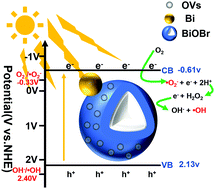Bi nanosphere-decorated oxygen-vacancy BiOBr hollow microspheres with exposed (110) facets to enhance the photocatalytic performance for the degradation of azo dyes†
Abstract
In this study, a novel composite photocatalyst of Bi nanosphere-decorated oxygen-vacancy BiOBr hollow microspheres with exposed (110) facets was successfully synthesized via a hydrothermal method. Also, the morphological, structural, chemical, and photoelectrical properties of this composite photocatalyst (Bi–BiOBr (OVs)) were further characterized. The surface plasmon resonance (SPR) effect of the Bi nanospheres, oxygen vacancies (OVs) with exposed (110) facets of BiOBr hollow microspheres, and the constructed Bi-BiOBr heterojunction were synergistically utilized to enhance the photocatalytic performance for the degradation of azo dyes. Benefiting from high light absorption, a low recombination rate of charge carriers, and abundant catalytic-activity sites in Bi-BiOBr (OVs), the efficient removal of both methyl orange (MO) and methyl red (MR) was achieved under simulated irradiation, in which the degradation efficiency for the above azo dyes could be up to nearly 100% within 40 min and 90 min, respectively. Most notably, this designed Bi-BiOBr (OVs) showed superior capacity with a highly competitive advantage for MO degradation via photocatalysis, which was among the best results reported so far.



 Please wait while we load your content...
Please wait while we load your content...